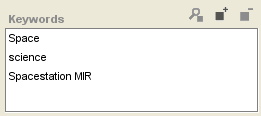Difference between revisions of "PrF UG inst entry field string"
| Line 18: | Line 18: | ||
It appears as an entry bar: | It appears as an entry bar: | ||
| − | <div>[[Image:PrF_UG_inst_entry_1.gif| | + | <div>[[Image:PrF_UG_inst_entry_1.gif|frame|none| |
| + | Single Cardinality entry field]]</div> | ||
<ul class='a'> | <ul class='a'> | ||
| Line 46: | Line 47: | ||
there is a limit on the number of values you can enter. | there is a limit on the number of values you can enter. | ||
| − | <div>[[Image:PrF_UG_inst_entry_string_multiple.png| | + | <div>[[Image:PrF_UG_inst_entry_string_multiple.png|frame|none| |
| − | + | Multiple Cardinality display list]]</div> | |
To edit a pre-existing value: | To edit a pre-existing value: | ||
| Line 58: | Line 59: | ||
<li><p> | <li><p> | ||
Click the <b>View Value</b> | Click the <b>View Value</b> | ||
| − | [[Image:PrF_UG_all_object.view.gif|all_object.view]] button. | + | ([[Image:PrF_UG_all_object.view.gif|all_object.view]]) button. |
An <b>Edit String Value</b> dialog box will be displayed. | An <b>Edit String Value</b> dialog box will be displayed. | ||
</p> | </p> | ||
| Line 76: | Line 77: | ||
<li><p> | <li><p> | ||
Click the <b>Create Value</b> | Click the <b>Create Value</b> | ||
| − | [[Image:PrF_UG_all_object.add.gif|all_object.add]] button. | + | ([[Image:PrF_UG_all_object.add.gif|all_object.add]]) button. |
A <b>Create String Value</b> dialog box will be displayed. | A <b>Create String Value</b> dialog box will be displayed. | ||
</p> | </p> | ||
| Line 103: | Line 104: | ||
<li><p> | <li><p> | ||
Click the <b>Remove Value</b> | Click the <b>Remove Value</b> | ||
| − | [[Image:PrF_UG_all_object.remove.gif|all_object.remove]] button. | + | ([[Image:PrF_UG_all_object.remove.gif|all_object.remove]]) button. |
The selected values will be removed. | The selected values will be removed. | ||
</p> | </p> | ||
Revision as of 15:27, October 22, 2008
The String Fields
When an instance is created for a class with a slot of String Value Type, the entry field corresponding to the slot is a String entry field. It takes ASCII characters as values, including upper and lowercase letters, numbers, and the basic symbols on the keyboard, such as !, _, and %. String values can also include spaces.
Single Cardinality
The entry field corresponding to a slot of value type String with Cardinality Single can contain a single ASCII string. It appears as an entry bar:
To edit a value, click in the entry field and make your edits.
To create a value, enter a string in the entry field.
To clear a value, delete the value in the entry field.
Multiple Cardinality
The entry field corresponding to a slot of type String with Cardinality Multiple shows a display list with three buttons. This field takes a list of string values. If the at most value is set in the Cardinality field for the slot, there is a limit on the number of values you can enter.
To edit a pre-existing value:
Select the value you want to edit.
Click the View Value (
 ) button.
An Edit String Value dialog box will be displayed.
) button.
An Edit String Value dialog box will be displayed.
Edit the string directly in the entry field in the dialog box.
Click OK.
To create a value:
Click the Create Value (
 ) button.
A Create String Value dialog box will be displayed.
) button.
A Create String Value dialog box will be displayed.
Enter a string in the entry field. You can enter ASCII characters, including upper and lowercase letters, numbers, and the basic symbols on the keyboard, such as !, _, and %. String values can also include spaces.
Click OK.
To remove a value:
Select the value(s) you want to remove.
Click the Remove Value (
 ) button.
The selected values will be removed.
) button.
The selected values will be removed.
